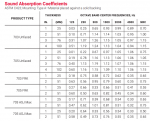Hi,
The room I record vocals in is 9 x 11, 8 feet high, if I count the entrance with the door, that wall is 13 feet long.
I built 8 absorbtion panels, 3 inch thick, 4 feet by 2 with safe and sound rockwool or roxul depending on where you live, I notice a very significant improvement when it comes to the reverb and echos being reduced in my room but it still isnt satisfactory to me. Yet most sites with calculators recommended a minimum of 2 panels or 4 total. yet I am not yielding results that I like.
I built a temporary vocal booth in the room with the panels, mounted on furniture etc it is 4 ft by 4ft six feet high, but I find the sound is too dead or seems to have a boomy and slightly too dull sound for my liking. I dont know if the boomy sound is because the back wall of the booth is the room wall and lacks absorption, or if it is simply too small. Ideally, I would like to have a room that is as dead as the booth, but less boomy.
Hence my next question, how many more panels would I need to build to achieve the goal I mentioned? Note I am only going to record vocals and mix in the cans as I dont have monitors.
Thanks
The room I record vocals in is 9 x 11, 8 feet high, if I count the entrance with the door, that wall is 13 feet long.
I built 8 absorbtion panels, 3 inch thick, 4 feet by 2 with safe and sound rockwool or roxul depending on where you live, I notice a very significant improvement when it comes to the reverb and echos being reduced in my room but it still isnt satisfactory to me. Yet most sites with calculators recommended a minimum of 2 panels or 4 total. yet I am not yielding results that I like.
I built a temporary vocal booth in the room with the panels, mounted on furniture etc it is 4 ft by 4ft six feet high, but I find the sound is too dead or seems to have a boomy and slightly too dull sound for my liking. I dont know if the boomy sound is because the back wall of the booth is the room wall and lacks absorption, or if it is simply too small. Ideally, I would like to have a room that is as dead as the booth, but less boomy.
Hence my next question, how many more panels would I need to build to achieve the goal I mentioned? Note I am only going to record vocals and mix in the cans as I dont have monitors.
Thanks



 .
. . I think OP just needs to get more treatment in there and start figuring out what works. With more treatment, the corners can be trapped, and first reflection points for recording, and maybe even monitoring, if they get to the point of setting up monitor speakers. Or, put another way, I think trying to make it work with 8 panels only is going to be more frustrating than 16 panels (about half of which should be bass traps).
. I think OP just needs to get more treatment in there and start figuring out what works. With more treatment, the corners can be trapped, and first reflection points for recording, and maybe even monitoring, if they get to the point of setting up monitor speakers. Or, put another way, I think trying to make it work with 8 panels only is going to be more frustrating than 16 panels (about half of which should be bass traps). ...so all I did the measurements for was to see the response of the room, but I didn't use any of them to suggest the type/size of trap (this was when I set up my old studio space)...and it was after the room was already set up and well treated, and I wanted to add some more bass traps...so I measured.
...so all I did the measurements for was to see the response of the room, but I didn't use any of them to suggest the type/size of trap (this was when I set up my old studio space)...and it was after the room was already set up and well treated, and I wanted to add some more bass traps...so I measured.